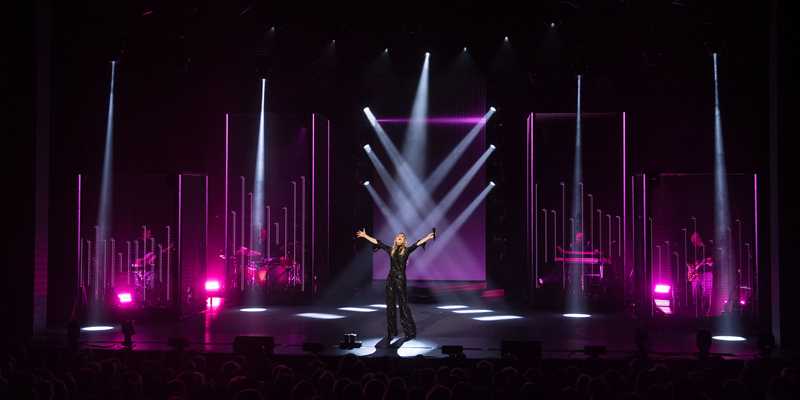Robe lights Véronic DiCaire Showgirl dates
- Details

The Showgirl concept saw the artist delivering material written / performed by around 50 female vocalists - from Dua Lipa to Celine Dion - in their style and voices, backed by six dancers and four musicians.
Matthieu proposed a harmonious and integrated set, lighting and video design which featured Robe moving lights at the centre, with 28 MegaPointes and 12 Spiiders, plus six BMFL Blades and two BMFL Spots being used with a RoboSpot remote follow-spotting system.
The stage architecture was defined by five distinctive LED columns onstage, a central flat-plane LED surface flanked by four three-sided columns with the four musicians in the middle, which allowed them to be concealed and revealed as desired. This highly effective visual trickery also preserved the form and structure of the performance space.
Working closely with the artist herself and her creative team including show director Josée Fortier, choreography / stage director Geneviève Dorion-Coupal and artistic director Patricia Ruel, Matthieu developed the lighting and video content together into a coherent aesthetic treatment for each segment of the show.
“Véronic was extremely clear that she wanted more abstract visuals and a fluid lighting and video design to support her performance,” he explained. With no wigs or costume changes, the different characters and their songs are all identified by the changes in her voice, and the audience needed to get the message in a few short seconds, so the production visuals keep the focus on DiCaire.
Matthieu has worked with DiCaire on some TV shows and specials previously, but this was his first tour design. He also collaborated closely with Pierre Martinez (lighting director on the last tour) and asked him onboard again in the same role.
The basic starting point for lighting the show was the band on stage. Each musician was positioned on an 8ft x 8ft riser, which DiCaire wanted visible - or not - throughout the set, so the first task was integrating these risers slickly into the stage design. Utilising blow-through screen with no PSU was the first phase of dealing with the ‘invisibility puzzle’.
The MegaPointes were mainly positioned on the overhead rig in a V-shaped configuration, and on two vertically hung drop-bars either side of the center screen.
Six of the 12 Spiiders lived on the most downstage overhead truss or LX fly bar, with six on the floor in the offstage footlights position for front lighting and washing across the stage in a range of colours.
On this show, all six BMFL Blades were rigged on the downstage truss where they doubled for front lighting and could be swung round to illuminate the audience. The two BMFL Spots on the RoboSpot system were also on the front truss.
Each song had its own colours, character and choreography, and as DiCaire is very particular about her spot operators, running a RoboSpot system enabled them to concentrate fully on following her movement accurately, while Pierre changed other parameters like colour, iris and intensity via the grandMA console on which he ran the show lighting.
Lighting and video equipment for the tour was supplied worldwide by Solotech.
(Jim Evans)
















